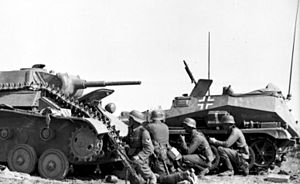
Back العملية الزرقاء Arabic ماوی مورد AZB Операция „Блау“ Bulgarian Cas Blau Catalan Operace Blau Czech Operation Blau Danish Fall Blau German Fall Blau Esperanto Operación Azul Spanish Operazio Urdina Basque
| Case Blue | |||||||
|---|---|---|---|---|---|---|---|
| Part of the Eastern Front of World War II | |||||||
 German troops take cover behind a knocked out T-70 light tank and beside a Sd.Kfz. 250 halftrack, summer 1942 | |||||||
| |||||||
| Belligerents | |||||||
|
| |||||||
| Commanders and leaders | |||||||
|
|
| ||||||
| Strength | |||||||
|
Initially: 1,570,287-1.805.000 (incl. Italian Eighth Army from early August)
|
Initially: 1,715,000[3] 1,000,000 (in reserve) 2,959–3,720 tanks[4][3] 1,671 aircraft[5] 16,500 artillery pieces[3] Total: 2,715,000 | ||||||
| Casualties and losses | |||||||
|
200,000[6] 700 tanks destroyed[6] ~150,000 Total: 350,000 (excluding 150,000 casualties in the first phase of the Battle of the Caucasus) |
1,200,000[6] 4,862 tanks and SPG destroyed or damaged[6] (including casualties in the first phase of the Battle of the Caucasus) | ||||||
Case Blue (German: Fall Blau) was the Wehrmacht's plan for the 1942 strategic summer offensive in southern Russia between 28 June and 24 November 1942, during World War II. The objective was to capture the oil fields of Baku (Azerbaijan SSR), Grozny and Maikop for two purposes: to enable the Germans to re-supply their low fuel stock and also to deny their use to the Soviet Union, thereby bringing about the complete collapse of the Soviet war effort.
After Operation Barbarossa failed to destroy the Soviet Union as a political and military threat the previous year, Adolf Hitler, the Führer of Nazi Germany, recognized that Germany was now locked in a war of attrition, and he was also aware that Germany was running low on fuel supply and would not be able to continue attacking deeper into enemy territory without more stock. With this in mind, Hitler ordered for the preparation of offensive plans for summer 1942 to secure the Soviet oil fields in the Caucasus. The operation involved a two-pronged attack: one from the Axis right flank against the oil fields of Baku, known as Operation Edelweiss, and one from the left flank to protect the first attack, moving in the direction of Stalingrad along the Don River, known as Operation Fischreiher.[7]
Army Group South (Heeresgruppe Süd) of the German Army was divided into Army Groups A and B (Heeresgruppe A and B). Army Group A was tasked with fulfilling Operation Edelweiss by crossing the Caucasus mountains to reach the Baku oil fields, while Army Group B protected its flanks along the Volga by fulfilling Operation Fischreiher. Supported by 2,035 Luftwaffe aircraft and 1,934 tanks and assault guns, the 1,570,287-man Army Group South began the offensive on 28 June, advancing 48 kilometers on the first day and easily brushing aside the 1,715,000 Red Army troops opposite, who wrongly expected a German offensive on Moscow even after Blau commenced. The Soviet collapse in the south allowed the Germans to capture the western part of Voronezh on 6 July and reach and cross the Don river near Stalingrad on 26 July. Army Group B's approach toward Stalingrad slowed in late July and early August owing to constant counterattacks by newly deployed Red Army reserves and overstretched German supply lines. The Germans defeated the Soviets in the Battle of Kalach and the combat shifted to the city itself in late August. Nonstop Luftwaffe airstrikes, artillery fire and street-to-street combat completely destroyed the city and inflicted heavy casualties on the opposing forces. After three months of battle, the Germans controlled 90% of Stalingrad on 19 November.
In the south, Army Group A captured Rostov on 23 July and swept south from the Don to the Caucasus, capturing the demolished oilfields at Maikop on 9 August and Elista on 13 August near the Caspian Sea coast. Heavy Soviet resistance and the long distances from Axis sources of supply reduced the Axis offensive to local advances only and prevented the Germans from completing their strategic objective of capturing the main Caucasus oilfield at Baku. Luftwaffe bombers destroyed the oilfields at Grozny but attacks on Baku were prevented by the insufficient range of the German fighters.
The Allies were concerned about the possibility of German forces continuing to the south and east and linking up with Japanese forces (then advancing in Burma) in India. However, the Red Army defeated the Germans at Stalingrad, following Operations Uranus and Little Saturn. This defeat forced the Axis to retreat from the Caucasus in order to avoid getting cut off by the Red Army, which was now advancing from Stalingrad towards Rostov in order to achieve the cut-off. Only the Kuban region remained tentatively occupied by Axis troops.[8][9]
- ^ Holt (2009), p. 47.
- ^ a b Liedtke 2016, p. 228.
- ^ a b c Liedtke 2016, p. 230.
- ^ Cite error: The named reference
A29was invoked but never defined (see the help page). - ^ Bergström 2007, pp. 49–50.
- ^ a b c d Mercatante 2012, p. 151.
- ^ Antill (2007), p. 40.
- ^ Cite error: The named reference
Nipe33was invoked but never defined (see the help page). - ^ Cite error: The named reference
a878was invoked but never defined (see the help page).
Cite error: There are <ref group=lower-alpha> tags or {{efn}} templates on this page, but the references will not show without a {{reflist|group=lower-alpha}} template or {{notelist}} template (see the help page).
© MMXXIII Rich X Search. We shall prevail. All rights reserved. Rich X Search